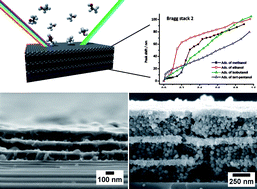One-dimensional metal–organic framework photonic crystals used as platforms for vapor sorption†
Abstract
We present the fabrication of one-dimensional photonic crystals (Bragg stacks) based on a microporous metal–organic framework material and mesoporous titanium dioxide. The Bragg stack heterostructures were obtained using two complementary synthesis approaches utilizing the bottom-up assembly of heterogeneous, i.e. two-component photonic crystal multilayer structures. Zeolitic imidazolate framework ZIF-8 and mesoporous titanium dioxide were chosen as functional components with different refractive indices. While ZIF-8 is intended to impart molecular selectivity, mesoporous TiO2 is used to ensure high refractive index contrast and to guarantee molecular diffusion within the Bragg stack. The combination of micro- and mesoporosity within one scaffold endows the 1D-MOF PC with characteristic

- This article is part of the themed collection: Integrating functionality into metal–organic frameworks

 Please wait while we load your content...
Please wait while we load your content...